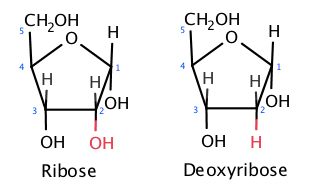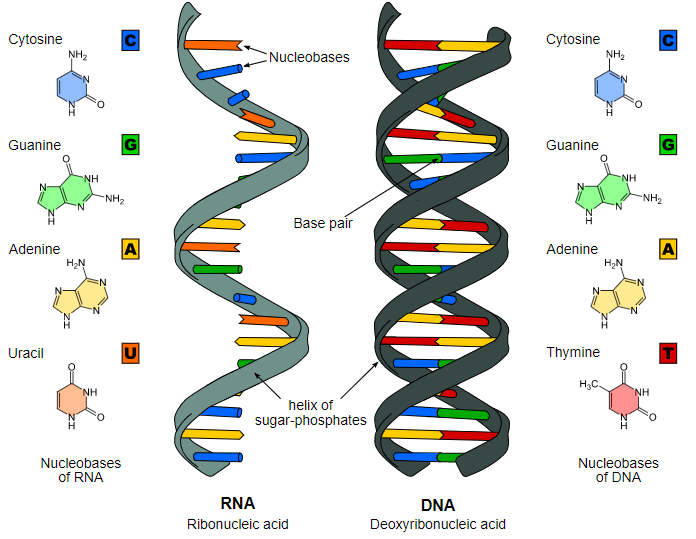
The chemical differences between DNA and RNA are
A. DNA has deoxyribose sugar and RNA has ribose sugar
B. DNA is double stranded and RNA is single stranded
C. Nitrogenous bases are only present in DNA
D. Both A and B
Answer
473.1k+ views
3 likes
Hint: DNA carries heredity characters within the chromosomes whereas RNA is the messenger of DNA. They are both linear polymers consisting of sugars, phosphates and nitrogen bases with slight key differences between them.
Complete answer:
DNA contains the sugar deoxyribose whereas RNA contains the sugar ribose. DNA contains one less oxygen than ribose.

DNA is double-stranded whereas RNA is usually single-stranded.

Nitrogenous bases are both present in DNA and RNA. DNA consists of four nitrogen bases - thymine, cytosine, adenine and guanine. RNA contains four nitrogen bases - uracil, cytosine, adenine and guanine. Hence, ‘option C’ is incorrect.
Hence, the correct answer is option (D).
Additional information:
-The full form of DNA is Deoxyribonucleic acid whereas the full form RNA is Ribonucleic acid.
-DNA is present in the nucleus and in mitochondria, a small amount of DNA is present. RNA is formed in the nucleolus and depending on the type of RNA, they are present in different regions of the cytoplasm.
-As DNA is double-stranded in nature, the geometry of the helix is β-form. As RNA is single-stranded in nature the geometry of the helix is α-form.
-For every species, the number of DNA remains the same whereas RNA numbers vary from cell to cell.
-DNA is more stable than RNA.
-DNA is more susceptible to UV light than RNA.
-DNA is generally self-replicating in nature whereas RNA is synthesised according to DNA’s need.
Note: DNA carries genetic information in specific genes and transfers them to the next generation. RNA helps to move the genetic code to produce proteins from the nucleus to the ribosomes. RNA can be divided into three main types – messenger RNA (mRNA), transfer RNA (tRNA) and ribosomal RNA (rRNA). The process of making an RNA copy of a gene sequence is known as transcription whereas the process of creating proteins from an mRNA template is known as translation.
Complete answer:
DNA contains the sugar deoxyribose whereas RNA contains the sugar ribose. DNA contains one less oxygen than ribose.

DNA is double-stranded whereas RNA is usually single-stranded.

Nitrogenous bases are both present in DNA and RNA. DNA consists of four nitrogen bases - thymine, cytosine, adenine and guanine. RNA contains four nitrogen bases - uracil, cytosine, adenine and guanine. Hence, ‘option C’ is incorrect.
Hence, the correct answer is option (D).
Additional information:
-The full form of DNA is Deoxyribonucleic acid whereas the full form RNA is Ribonucleic acid.
-DNA is present in the nucleus and in mitochondria, a small amount of DNA is present. RNA is formed in the nucleolus and depending on the type of RNA, they are present in different regions of the cytoplasm.
-As DNA is double-stranded in nature, the geometry of the helix is β-form. As RNA is single-stranded in nature the geometry of the helix is α-form.
-For every species, the number of DNA remains the same whereas RNA numbers vary from cell to cell.
-DNA is more stable than RNA.
-DNA is more susceptible to UV light than RNA.
-DNA is generally self-replicating in nature whereas RNA is synthesised according to DNA’s need.
Note: DNA carries genetic information in specific genes and transfers them to the next generation. RNA helps to move the genetic code to produce proteins from the nucleus to the ribosomes. RNA can be divided into three main types – messenger RNA (mRNA), transfer RNA (tRNA) and ribosomal RNA (rRNA). The process of making an RNA copy of a gene sequence is known as transcription whereas the process of creating proteins from an mRNA template is known as translation.
Recently Updated Pages
Express the following as a fraction and simplify a class 7 maths CBSE

The length and width of a rectangle are in ratio of class 7 maths CBSE

The ratio of the income to the expenditure of a family class 7 maths CBSE

How do you write 025 million in scientific notatio class 7 maths CBSE

How do you convert 295 meters per second to kilometers class 7 maths CBSE

Write the following in Roman numerals 25819 class 7 maths CBSE

Trending doubts
Give 10 examples of unisexual and bisexual flowers

Draw a labelled sketch of the human eye class 12 physics CBSE

Differentiate between homogeneous and heterogeneous class 12 chemistry CBSE

Differentiate between insitu conservation and exsitu class 12 biology CBSE

What are the major means of transport Explain each class 12 social science CBSE

Franz thinks Will they make them sing in German even class 12 english CBSE




